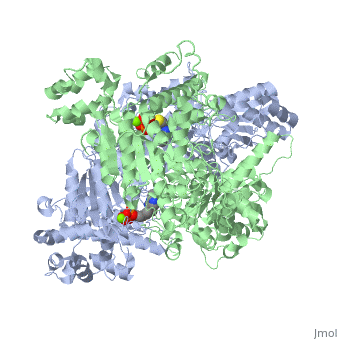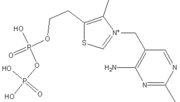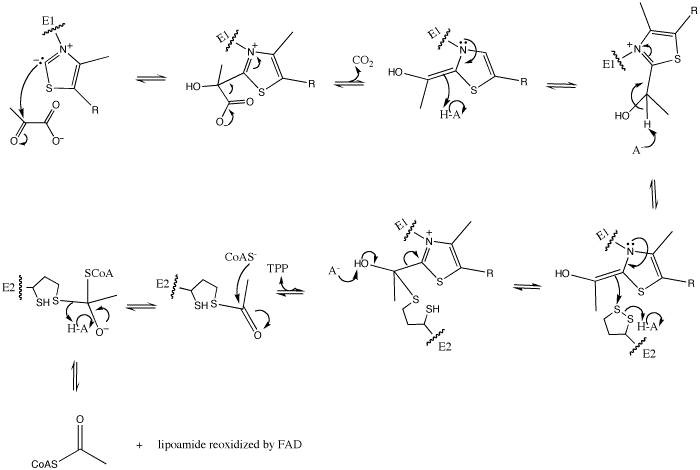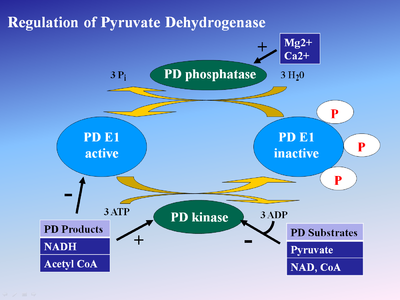Pyruvate dehydrogenase
From Proteopedia
(Difference between revisions)
| Line 47: | Line 47: | ||
Pyruvate dehydrogenase (PDH) deficiency is a congenital degenerative metabolic disease resulting from a mutation of the pyruvate dehydrogenase complex (PDC) located on the X chromosome. Although defects have been identified in all 3 enzymes of the complex, the E1-α subunit is predominantly the culprit. Malfunction of the citric acid cycle due to PDH deficiency deprives the body of energy and leads to an abnormal buildup of lactate. PDH deficiency is a common cause of lactic acidosis in newborns and often presents with severe lethargy, poor feeding, tachypnea, and cases of death have occurred<ref>Frye, Richard E., and Paul J. Benke. "Pyruvate Dehydrogenase Complex Deficiency." EMedicine. 11 Dec. 2007. WebMD. 14 Dec. 2008 </ref>. | Pyruvate dehydrogenase (PDH) deficiency is a congenital degenerative metabolic disease resulting from a mutation of the pyruvate dehydrogenase complex (PDC) located on the X chromosome. Although defects have been identified in all 3 enzymes of the complex, the E1-α subunit is predominantly the culprit. Malfunction of the citric acid cycle due to PDH deficiency deprives the body of energy and leads to an abnormal buildup of lactate. PDH deficiency is a common cause of lactic acidosis in newborns and often presents with severe lethargy, poor feeding, tachypnea, and cases of death have occurred<ref>Frye, Richard E., and Paul J. Benke. "Pyruvate Dehydrogenase Complex Deficiency." EMedicine. 11 Dec. 2007. WebMD. 14 Dec. 2008 </ref>. | ||
| + | |||
| + | ==3D structures of pyruvate dehydrogenase== | ||
| + | [[Pyruvate dehydrogenase 3D structures]] | ||
| + | |||
</StructureSection> | </StructureSection> | ||
==3D structures of pyruvate dehydrogenase== | ==3D structures of pyruvate dehydrogenase== | ||
| Line 55: | Line 59: | ||
*Pyruvate dehydrogenase E1 domain | *Pyruvate dehydrogenase E1 domain | ||
| + | **[[3exe]] - hPDH E1 α + β subunits - human<BR /> | ||
| + | **[[1ni4]], [[6cfo]] – hPDH E1 α + β (mutant) subunits <BR /> | ||
| + | **[[2ozl]], [[3exg]], [[3exh]], [[3exi]], [[6cer]] - hPDH E1 α (mutant) + β subunits<BR /> | ||
**[[1ik6]] – PaPDH E1 β subunit – ''Pyrobaculum aerophilum''<BR /> | **[[1ik6]] – PaPDH E1 β subunit – ''Pyrobaculum aerophilum''<BR /> | ||
**[[1l8a]], [[2g25]], [[2g67]], [[2iea]] – EcPDH E1 – ''Escherichia coli''<BR /> | **[[1l8a]], [[2g25]], [[2g67]], [[2iea]] – EcPDH E1 – ''Escherichia coli''<BR /> | ||
| Line 62: | Line 69: | ||
**[[1rp7]] - EcPDH E1 + inhibitor<BR /> | **[[1rp7]] - EcPDH E1 + inhibitor<BR /> | ||
**[[4qoy]] - EcPDH E1 + PDH E2<br /> | **[[4qoy]] - EcPDH E1 + PDH E2<br /> | ||
| - | **[[3exe]] - hPDH E1 α + β subunits - human<BR /> | ||
| - | **[[1ni4]], [[6cfo]] – hPDH E1 α + β (mutant) subunits <BR /> | ||
| - | **[[2ozl]], [[3exg]], [[3exh]], [[3exi]], [[6cer]] - hPDH E1 α (mutant) + β subunits<BR /> | ||
**[[3exf]] - hPDH E1 α (mutant) + β subunits + TDP | **[[3exf]] - hPDH E1 α (mutant) + β subunits + TDP | ||
| Line 77: | Line 81: | ||
*Pyruvate dehydrogenase E3 domain | *Pyruvate dehydrogenase E3 domain | ||
| - | **[[ | + | **[[6h60]] – hPDH protein X – Cryo EM<br /> |
| - | + | ||
| - | + | ||
**[[1zy8]] – hPDH protein X + dihydrolipoyl dehydrogenase<BR /> | **[[1zy8]] – hPDH protein X + dihydrolipoyl dehydrogenase<BR /> | ||
**[[2f5z]] - hPDH protein X (mutant) + dihydrolipoyl dehydrogenase<BR /> | **[[2f5z]] - hPDH protein X (mutant) + dihydrolipoyl dehydrogenase<BR /> | ||
| Line 85: | Line 87: | ||
**[[2dnc]], [[2dne]] - hPDH protein X N terminal - NMR<BR /> | **[[2dnc]], [[2dne]] - hPDH protein X N terminal - NMR<BR /> | ||
**[[2g25]] - hPDH protein X + phosphonolactylthiamin diphosphate<BR /> | **[[2g25]] - hPDH protein X + phosphonolactylthiamin diphosphate<BR /> | ||
| - | **[[2g28]] - hPDH protein X (mutant) + phosphonolactylthiamin diphosphate | + | **[[2g28]] - hPDH protein X (mutant) + phosphonolactylthiamin diphosphate<br /> |
| + | **[[2eq6]] – TtPDH E3 – ''Thermus thermophilus''<BR /> | ||
| + | **[[4jdr]] – EcPDH E3<br /> | ||
| + | **[[1gjx]] – PDH E3 lipoyl domain – ''Neisseria meningitis'' – NMR<br /> | ||
| + | |||
}} | }} | ||
Revision as of 11:18, 5 December 2019
| |||||||||||
3D structures of pyruvate dehydrogenase
Updated on 05-December-2019
References
- ↑ Protein: Pyruvate dehydrogenase E1-beta, PdhB, C-terminal domain from Bacillus stearothermophilus. (2009). Retrieved from http://scop.mrc-lmb.cam.ac.uk
- ↑ Ciszak EM, Korotchkina LG, Dominiak PM, Sidhu S, Patel MS (June 2003). "Structural basis for flip-flop action of thiamin pyrophosphate-dependent enzymes revealed by human pyruvate dehydrogenase". J. Biol. Chem. 278 (23): 21240–6
- ↑ 3.0 3.1 Arjunan P, Nemeria N, Brunskill A, Chandrasekhar K, Sax M, Yan Y, Jordan F, Guest JR, Furey W. Structure of the pyruvate dehydrogenase multienzyme complex E1 component from Escherichia coli at 1.85 A resolution. Biochemistry. 2002 Apr 23;41(16):5213-21. PMID:11955070
- ↑ Jmol: an open-source Java viewer for chemical structures in 3D. http://www.jmol.org/
- ↑ 5.0 5.1 5.2 Voet, D., Voet, J.G., and Pratt, C.W. (2008). Fundamentals of biochemistry. Hoboken, NJ: John Wiley and Sons, Inc.
- ↑ Korotchkina LG, Patel MS. Probing the mechanism of inactivation of human pyruvate dehydrogenase by phosphorylation of three sites. J Biol Chem. 2001 Feb 23;276(8):5731-8. Epub 2000 Nov 22. PMID:11092882 doi:10.1074/jbc.M007558200
- ↑ Roche TE, Hiromasa Y. Pyruvate dehydrogenase kinase regulatory mechanisms and inhibition in treating diabetes, heart ischemia, and cancer. Cell Mol Life Sci. 2007 Apr;64(7-8):830-49. PMID:17310282 doi:10.1007/s00018-007-6380-z
- ↑ Bisswanger, H. Substrate specificity of the pyruvate dehydrogenase complex from escherichia coli. J Biol Chem. 1981. Jan 25;256(2):815-822.
- ↑ Leung PS, Rossaro L, Davis PA, et al. (2007). "Antimitochondrial antibodies in acute liver failure: Implications for primary biliary cirrhosis". Hepatology 46 (5): 1436
- ↑ Frye, Richard E., and Paul J. Benke. "Pyruvate Dehydrogenase Complex Deficiency." EMedicine. 11 Dec. 2007. WebMD. 14 Dec. 2008




